Article and photos by Joe Sapia
Note: The yard references are to my house in the section of Monroe between Helmetta and Jamesburg in South Middlesex County. My yard is in a Pine Barrens outlier on the Inner Coastal Plain, the soil is loamy, and my neighborhood is on the boundary of Gardening Zones 6b (cooler) and 7a (warmer). Notes and photographs are for the period covered, unless otherwise noted.
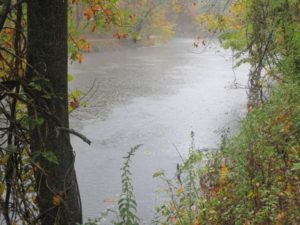
Nor’easter rain pelts the Delaware and Raritan Canal at Kingston, which overlaps the boundary of Franklin, Somerset County, and South Brunswick, Middlesex County. This photograph was taken on the Somerset County side of Route 27.
NOR’EASTER: The Sunday-Monday, October 29-30, nor’easter dropped large amounts of rain throughout the Jersey Midlands. The National Weather Service unofficial high totals from weather stations in the Jersey Midlands portion of seven counties: Hunterdon, up to 4.91 inches in High Bridge; Somerset, up to 4.5 inches in Bernards; Middlesex, up to 3.79 inches in northeast South Brunswick; Monmouth, up to 4.74 inches in West Long Branch; Ocean, up to 5.45 inches in Berkeley; Burlington, up to 4.62 inches in Roebling; and Mercer, up to 5.42 in west Princeton.
The nor’easter also brought reported maximum wind gusts of: Hunterdon, 45 miles per hour at Frenchtown; Middlesex, 52 MPH in the Raritan River/Perth Amboy area; Monmouth, 49 MPH at north Long Branch; Ocean, 58 MPH in the Beach Haven area; Burlington, 47 MPH at Jobstown; and Mercer, 40 MPH at Mercer County Airport.
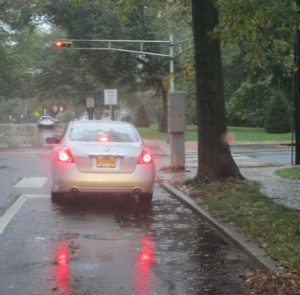
Water pools on a roadway in Princeton, Mercer County, during the nor’easter Sunday, October 29.
NOR’EASTER, BEFORE AND AFTER: Before the Sunday-Monday, October 29-30, nor’easter, all seven Midlands counties had a deficit of rainfall over the last three months. After the nor’easter, only Hunterdon and Mercer have deficits. According to National Weather Service, three-month rainfalls as of Thursday, November 2, were: Hunterdon, 10.7 inches total over the last three months, minus 1.8 inches; Somerset, 12.4 inches, plus .2 inches; Middlesex, 12.0 inches, even; Monmouth, plus .2 inches; Ocean, 12.0 inches, plus .7 inches; Burlington, 11.8 inches, plus .2 inches; and Mercer, 10.2 inches, minus 1.8 inches.
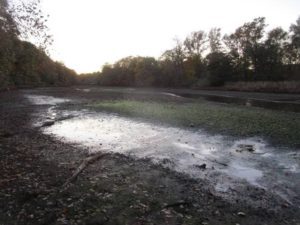
Farrington Lake – here, on the boundary of South Brunswick and East Brunswick looking to North Brunswick, all in Middlesex County – in the days before the Sunday-Monday, October 29-30, nor’easter.
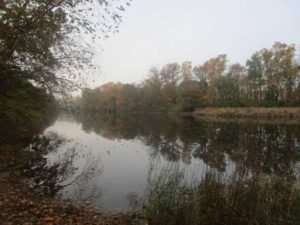
The same view of Farrington Lake in the days after the nor’easter.
FALLEN LEAVES ON ROADWAYS: Motorists, be careful of braking with fallen leaves on the roadway, especially in wet conditions.
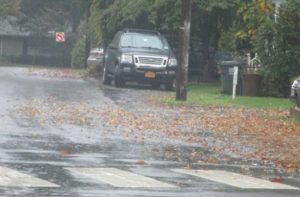
Leaves cover a roadway in the Kingston section of Franklin, Somerset County, during the October 29-30 nor’easter.
FALL FOLIAGE: The fall colors have really brightened, although there is still much green out there and a lot that has already turned color. I am thinking we are in the midst of our (erratic) peak, so enjoy it while it lasts.
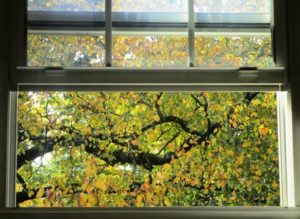
The changing colors of the fall foliage in New Brunswick, Middlesex County, as seen through the window of the Rutgers University Plangere Writing Center.
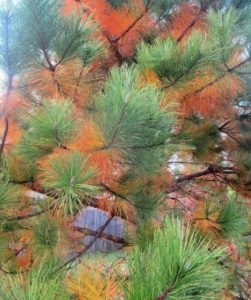
Shattering two myths: One, pine trees are evergreens, but they do shed needles. Here, a pitch pine, “Pinus rigida,” the most common pine of the New Jersey Pine Barrens. This one is in my backyard in Monroe, Middlesex County, but transplanted from the wilds of the Pine Barrens of Monmouth County. Two, the Pine Barrens are not barren. Actually, the Pines are a great place to see the changing colors of the fall, contrasting with the greens of pitch pines and other evergreens.
DEER RUT: As I have mentioned, I am seeing something I do not normally see – adult male deer, “Odocoileus virginianus.” But it is the mating season, or rut, so bucks are moving. On the night of Wednesday, November 1, I saw a buck as I drove through an East Brunswick section of the Jamesburg Park Conservation Area. He trotted into the woods. We appear to still be in the first phase of the rut – bucks following female deer in search of receptive does. The second phase will be mating, the third phase being the rut winding down – the rut lasting until about mid-December. With sex-crazed deer running around, be careful driving.
VOICE FROM AFIELD, JOAN GETAZ ZUMOFF: I still not have seen any “snowbirds,” or juncos, “Junco hyemalis,” at my house in Monroe, Middlesex County. But I expect them any day down for the colder weather from probably as far north as Canada. Actually, they are likely around already and I just have not seen any yet, because Joan Getaz Zumoff checked in just below the Midlands — from Gloucester Township, Camden County, where she had a first sighting Oct. 27. My rule of thumb for snowbirds at my house is around Halloween, October 31. But this has been a wacky year with the weather.
IS IT FALL YET?: Depending on the day, it could be frosty or summer-like. This week, I was shooting photographs at Farrington Lake in Middlesex County. At the part of the lake on the boundary where North Brunswick, East Brunswick, and South Brunswick meet, I am pretty sure I heard a spring peeper treefrog, “Pseudacris crucifer.” The normal time to begin hearing their calls is around early March – that harbinger of spring that sounds like sleigh bells coming from swamps – and, then, they are pretty much done as the spring warms up toward summer.
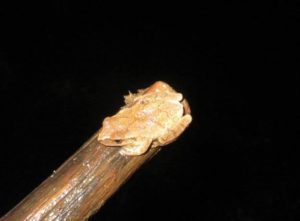
I photographed this spring peeper treefrog in the Manalapan Brook floodplain in Monroe, Middlesex County, in March. They are early spring callers. But I am pretty sure I heard the species calling this week at Farrington Lake on the boundary of North Brunswick, East Brunswick, and South Brunswick, all in Middlesex County – one of those aberrations of nature.
BLOOMING FLOWERS: Garden flowers continued blooming. In Kingston, on the South Brunswick, Middlesex County, side, for example, I saw a beautiful planting of zinnias along Route 27 in front of the Eno Terra restaurant.
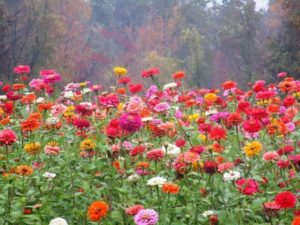
Here in Kingston on the South Brunswick, Middlesex County, side of Route 27, grows an ornamental planting of zinnias with the fall foliage colors in the background.
VOICE FROM AFIELD, CHRIS BEVINS: Chris Bevins checked in from Monroe, Middlesex County, where he works for the Utility Department: “I was working on a project this morning and the irrigation pond at the end of England Road on the field had a mated pair of freshwater otters eating fish and frolicking.” I hope to see them, because I have never seen an otter, “Lontra canadensis.”
MY GARDEN: My vegetable garden – between Helmetta and Jamesburg in South Middlesex County — took a licking because of heavy rain over the summer. Other than the colorful and pollinating-attracting zinnias, it was a bad year – basically only a bit of sweet corn to show for the work. But, then this week, I harvested some of my early spring plantings of Lake Valley “Rainbow Blend” carrots. Now, I will watch to see how my late-season planting of carrots does.
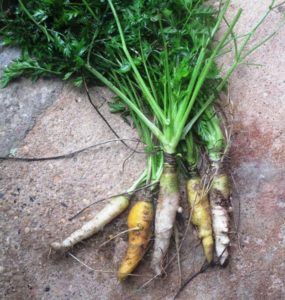
Planted April 8 as part of my early crop, these Lake Valley “Rainbow Blend” heirloom carrots were harvested Sunday, October 29.
VOICE FROM THE GARDEN, PAUL MIGUT: Paul Migut, now in his early 60s, who has been gardening since childhood, reported in from South River, Middlesex County: “November 2, a balmy 75f. Garden cleaned out and tilled up. A few eggplants picked and one grape tomato plant still hanging in there. While no match for Pon’s garden from days of old” – a reference to his Uncle Stanley “Pon” Ceslowski and his garden in Monroe, Middlesex County – “my 20 feet by 20 feet section still manages to provide vegetables for the two of us” – Paul and his wife, Karen – “and then some.”
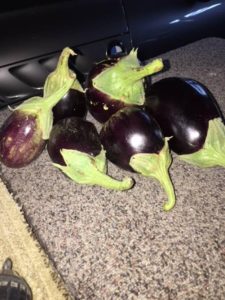
The “last of the eggplants,” according to Paul Migut, from his South River, Middlesex County, garden.
DRIVE-BY NATURALIST, VULTURES: During the nor’easter, I came across these vultures in the Monmouth Junction section of South Brunswick, Middlesex County.
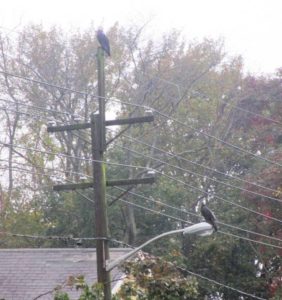
Vultures across the street from the Monmouth Junction Elementary School in South Brunswick, Middlesex County.
DRIVE-BY NATURALIST, HAZY SKY: On Thursday, November 2, I awoke to weather reports warning of fog. By the time I left the house around 8 a.m., though, there was no ground-level fog to speak of, but the sky had a haze. Sunshine fighting through that haze provided a beautiful view – one to photograph.
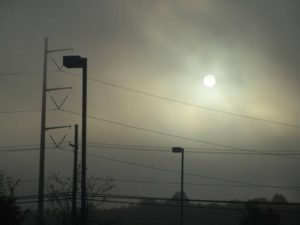
The sun breaks through the haze over the Jamesburg Park Conservation Area on the boundary of South Brunswick and East Brunswick, both in Middlesex County.
CLOUDS, NEW BRUNSWICK: Beautiful cloud views continue. This week, for example, at New Brunswick, Middlesex County – the Douglass-Cook campus of Rutgers University and along the Raritan River.
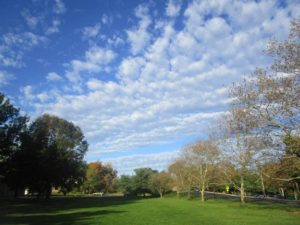
Clouds above the Douglass-Cook campus at Rutgers University in New Brunswick, Middlesex County.

Over the Raritan River from George Street in New Brunswick, Middlesex County.
RUTGERS UNIVERSITY SQUIRRELS: As I walk through the Rutgers University College Avenue and Douglass-Cook campuses in New Brunswick, Middlesex County, Mondays through Fridays, I find the squirrels, “Sciurus carolinensis,” entertaining and numerous. If I were a squirrel in New Brunswick, I probably would pick the garden-y campus, rather than the urban sectors.
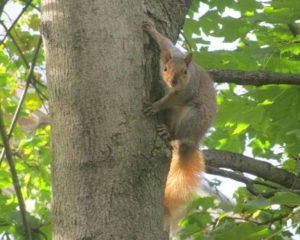
This squirrel has quite a bit of red tint.
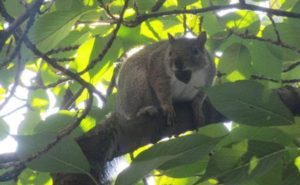
Acting as a squirrel with acorn in mouth.
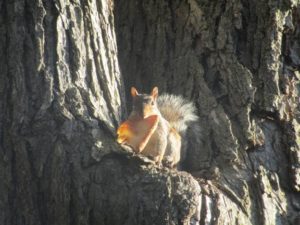
This squirrel was acting like a human, with some kind of bread in its mouth.
OCEAN TEMPERATURES: Atlantic Ocean temperatures on the New Jersey coast were about 60 degrees to 62 degrees over the November 4-5 weekend.

On the banks of the old Raritan River, looking downstream from New Brunswick, across the river to Highland Park, both in Middlesex County.
CHANGE THE CLOCKS: We switch from Daylight Savings Time to Standard Time November 5, Sunday, at 2 a.m., the clocks moving back to 1 a.m.
SUNRISE/SUNSET: For November 5, Sunday, to November 11, Saturday, the sun will rise about 6:35 a.m. set about 4:45 p.m. For November 12, Sunday, to November 18, Saturday, the sun will rise about 6:40 to 6:45 a.m. and set about 4:35 to 4:40 p.m.
WEATHER: The National Weather Service forecasting station for the area is at http://www.weather.gov/phi/.

Pictured is the Full Frost Moon on the November 3-4 overnight. The next full moon is the Long Night Moon on the December 2-3 overnight.
A PARTING NOTE, HAIKU: The Japanese poetry style of 5 syllables, 7 syllables, and, finally, 5 syllables:
Look into the woods –
The leaves are changing colors.
Yellow, orange, red.
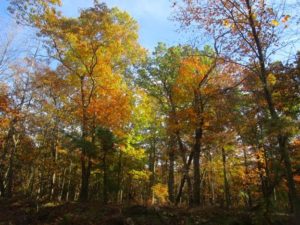
Leaves changing colors in the Pine Barrens around Helmetta, Middlesex County.
Joe Sapia, 60, is a lifelong resident of Monroe — in South Middlesex County, where his maternal family settled more than 100 years ago. He is a Pine Barrens naturalist and a gardener of organic vegetables and fruit, along with zinnias and roses. He draws inspiration on the Pine Barrens around Helmetta from his mother, Sophie Onda Sapia, who lived her whole life in these Pines, and his Polish-immigrant grandmother, Annie Poznanski Onda. He gardens the same backyard plot as did his Grandma Annie and Italian-American father, Joe Sr. Both are inspirations for his food gardening. Ma inspires his rose gardening. Joe’s work also is at @JosephSapia on Twitter.com, along with Facebook.com on the Jersey Midlands page.
Thursday October 12 is “Imagine a Day Without Water” Day. Can you even begin to imagine a day without water? It isn’t just your personal use of water – brushing your teeth, flushing your toilet, taking a shower – though those rituals are vital. Water is also essential to a functioning economy. What is a college campus or a hotel supposed to do if there is no water? They close. How can a restaurant, coffee shop, or brewery serve customers without water to cook, make coffee and beer, or wash the dishes? They can’t. And what about manufacturers – from pharmaceuticals to automobiles – that rely on water? They would grind to a halt too. An economic study released by the Value of Water Campaign earlier this year found that a single nationwide day without water service would put $43.5 billion of economic activity at risk.
Imagine a Day Without Water is an annual day of awareness that highlights the importance of safe, affordable water to all facets of everyday life. In recognition of the 2017 Imagine A Day Without Water, the Lower Raritan Watershed Partnership is unveiling our new “Community Resources for Water Quality” tool developed to improve the accessibility of information about preserving water quality for folks in the Lower Raritan Watershed. The “Community Resources for Water Quality” tool lists and describes publications and other types of materials available through the Rutgers-New Jersey Agricultural Experiment Station (NJAES) specific to maintaining or improving water condition in our communities. The tool is designed to assist Environmental Commissions, Green Teams and/or other interested residents to improve, preserve and restore stream areas and watersheds. We think it’s pretty neat!
Water is a public health issue, it is an economic issue. No community can thrive without water, and everyone deserves a safe, reliable, accessible water supply. Our new tool highlights things that every one of us can do to preserve and improve our water resources to make sure that no one ever has to imagine a day without water again. Please check out the tool, and let us know how it inspires you to preserve or restore our water resources!
With thanks to Rutgers-NJAES and Joan Kaplan with the Rutgers Environmental Steward program for their assistance in developing this tool.
Article and photos by Joe Mish
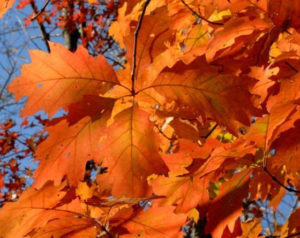
Black oak leaves are ablaze in the most incredible orange color, which makes you wonder how the black oak got its name.
A robe of many colors is October’s alone to wear. It is a coarse cloth, woven with silken threads of yellow and orange, melting into the extreme end of the red spectrum. Set against a clear blue sky, the colors radiate with brilliance. While the sun is otherwise occupied behind gathering clouds, the colors are no less extraordinary, as they hold their sharp contrast, presenting with a soft matte finish.
As the robe is placed upon the earth’s shoulders, the colors slowly flow downward in an infinitely slow progression, best seen from high above the earth. With that image in mind, it is easy to visualize autumn as a living creature leaving a momentary trail of color across the breadth of the tilting earth.
An alternative to a live, time lapsed satellite image of autumn’s gradual crawl across the latitudes, is best seen from a lofty vantage point with expansive views. Though the view is static, the full range of colors is on display. The cloth of the colorful cloak lies tight against the contour of the wooded mountains, each undulating feature of the landscape accentuated by shade and light. On a typical sunlit October day, herds of white billowy clouds drift across the blue sky followed on the ground by their shadows trying to keep up. As the lagging shadows flow across the colorful mountainsides, the tints change for a brief moment to provide a sense of movement to an otherwise still image. The scene is more dramatic if you can imagine the passing shadows being that of the artist’s hand working as you watch.
Retreating from distant views to stand within the October woodlands, individual trees and stands of trees become the focus. Each species resplendent in their own genetically defined color, modified to some degree by soil conditions, specifically, available nutrients and moisture. Instead of looking at a mass of treetops where smudges of varied colors blend together, we now see the pixels that make up the distant image.
Comparing trees of the same species, we can see the individual variation of color. Many trees with yellow leaves such as hickories, Norway maples, cherry and tulip poplar trees are very consistent in color. Oaks, sweetgum and some maples, whose leaves have a red component, show the most diversity.
The most glorious displays of fall color are where we find them, scattered among the local landscape. Each, an emissary heralding the arrival of autumn; apart from the mass of color sweeping across the land.
We all have a perennial favorite we watch on a daily basis to gauge the progress of autumn color.
A lone white oak in the middle of a field or a native red maple pressing against the chain link fence in the backyard, as seen from the bathroom window, serve as daily alerts.
Among the many autumn images accumulated in my experience, the one that keeps appearing is an old abandoned farm road lined with Norway maples, all the same size. The tree tops form a tight canopy over the road, keeping it clear of weeds and paving it with a golden carpet of fallen leaves. The length of the yellow paved road has a hint of a vanishing point that beckons a traveler to follow deeper into the fire of autumn color.
Author Joe Mish has been running wild in New Jersey since childhood when he found ways to escape his mother’s watchful eyes. He continues to trek the swamps, rivers and thickets seeking to share, with the residents and visitors, all of the state’s natural beauty hidden within full view. To read more of his writing and view more of his gorgeous photographs visit Winter Bear Rising, his wordpress blog. Joe’s series “Nature on the Raritan, Hidden in Plain View” runs monthly as part of the LRWP “Voices of the Watershed” series. Writing and photos used with permission from the author.
Article and photos by Joe Sapia
Note: The yard references are to my house in the section of Monroe between Helmetta and Jamesburg in South Middlesex County. My yard is in a Pine Barrens outlier on the Inner Coastal Plain, the soil is loamy, and my neighborhood is on the boundary of Gardening Zones 6b (cooler) and 7a (warmer). Notes and photographs are for the period covered, unless otherwise noted.

Dawn on the Delaware River, looking downstream from Hamilton, Mercer County, to the other side of the river and Bucks County, Pennsylvania.
ABBOTT MARSHLANDS: The Abbott Marshlands are about 3,000 acres, about 1,300 wetlands and 1,700 uplands, along the Delaware River on the boundary of Burlington and Mercer counties in the Bordentown-Trenton area. An interesting point of the marsh is that it is both freshwater and tidal. While Delaware River saltwater going inland ends between the Delaware Memorial Bridge and Philadelphia, the tidal effect continues for miles upstream to the Marshlands. The Marshlands also are known as the Trenton Marsh and the Hamilton Marsh. More information is at http://abbottmarshlands.org/.
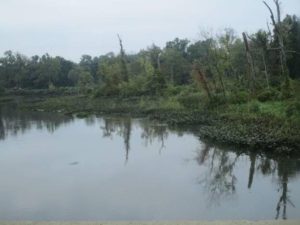
The Abbott Marshlands at Hamilton, Mercer County.
MONARCH BUTTERFLIES: Watch for monarch butterflies, “Danaus plexippus,” on their southern migration, to either Florida or, more likely, Mexico. This “super generation” are the great-grandchildren of last fall’s migrators and will make the complete migration. However, next year, they will begin northward, but will only make it so far, requiring three breedings to complete the journey north. Then, those great-grandchildren will become a “super generation,” making the entire journey south.
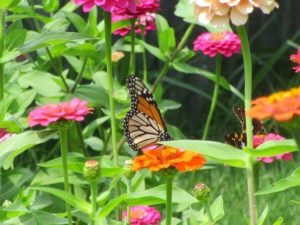
A monarch butterfly in my garden in August.
DRIVE-BY NATURALIST, BLACK VULTURES: I was driving to Princeton, Mercer County, to meet the lovely Pamela for breakfast and came across quite a scene on Route 27 in South Brunswick, Middlesex County – dozens of black vultures, “Coragyps atratus,” feeding on a dead deer. (As I mentioned last month, I do not recall seeing a black vulture locally until probably the 1990s. They are a southern species that has moved north.) Remember, nature is all around us, just keep an eye out for it.
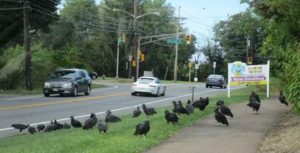
Black vultures on Route 27 in South Brunswick, Middlesex County.
DRIVE-BY NATURALIST, CHESTNUT TREES: As I was driving through the Pine Barrens around Helmetta, I noticed a Middlesex County Parks and Recreation pickup at the Jamesburg Park Conservation Area. I had to talk to naturalist Eric Gehring about a volunteer project, so I turned around and pulled over. Eric was on a mission with Les Nichols of the American Chestnut Foundation, looking for chestnut trees, “Castanea dentata,” in the Conservation Area. Since around 1900, the American chestnut has been plagued by a non-native and extremely invasive and potent fungal blight, “Cryphonectria parasitica,” – estimated to have crippled up to 4 billion chestnuts initially. American Chestnut blight affects the tree upward from where it infects it. The tree, then, is able to sprout again from roots, only to have those shoots, except for rare cases, infected. The Foundation seeks good specimens, hoping to create resistance in future chestnuts. Eric asked if I knew of chestnuts growing in these woods. Yes, at Swing Hill (which Eric already knew about) and at Big Tree. Into the woods, we headed – on my part unexpectedly, but I would rather walk the woods my family has walked for more than 100 years than do chores around the house – looking for specimens that may produce sought-after seeds in the future.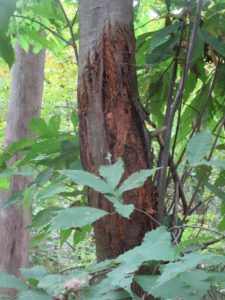
An American chestnut, in the Pine Barrens around Helmetta, infected with the fungal blight.
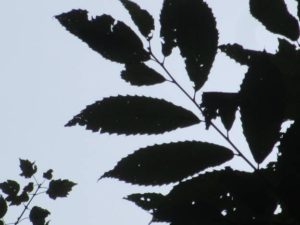
American chestnut leaves in silhouette – serrated with a surf wave-like pattern.
STINK BUGS: I had noticed one or two brown marmorated stink bugs, “Halyomorpha halys,” outside the house. This is an Asian species, apparently introduced accidentally in the Allentown, Pennsylvania, area in 1996. This week, I found one in the house on a blind in my living room — perhaps just the beginning of an infiltration for their overwintering. As a Rutgers University fact sheet says, “They enter houses through cracks in windows and the foundation and may be seen in large numbers during September and October.” If you go after one and, say, crush it, it will release an earthy odor. So, it is a nuisance, not a damaging bug to the house. However, it is a serious threat to crops. More information is available at https://njaes.rutgers.edu/stinkbug/. (As for crickets in the house, my $45,000 cricket deterrent project – that is the remodeling with the side benefit of keeping crickets out of the house – seems to be working. So far, only 8 crickets in the cellar and 2 in the living section of the house. A cacophony of crickets is beautiful music. A single cricket rubbing its legs in the wee hours like the fingernail scratching of a blackboard. While cleaning the garage, I may have discovered their last main intrusion route into the living section – through a crack/opening between garage floor and foundation.)
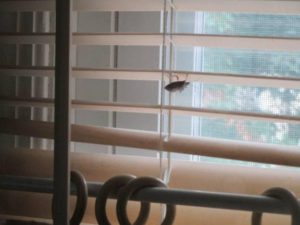
marmorated stink bug on a living room blind.
BIRD FEEDING: This is the first summer in years I have not gone all out feeding the birds in my yard. I miss watching them, but I saved quite a bit of money (because I use only sunflower hearts or kernels) and tried something new, letting the birds eat insects, serving as a natural pesticide. But the bird-feeder is back up and the birds are slowly discovering it. I am looking forward to beginning my day watching birds feed.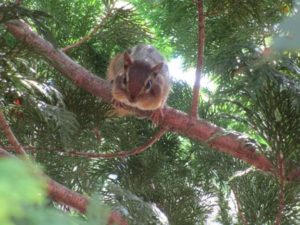
A chipmunk, “Tamias striatus,” in the yard.
FERRIS FARMS: Now that I am feeding the birds in my yard again, I stopped by my regular bird food supplier, Ferris Farms in East Brunswick, Middlesex County. I recall visiting Ferris as a youngster with my family. Mike Rutkowski and Tony Riccobono have always been friendly and helpful when I have asked gardening questions. See http://www.ferrisfarms.org/.
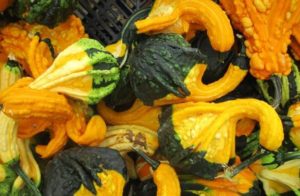
Gourds at Ferris Farms in East Brunswick, Middlesex County.

Pansies at Ferris Farms.
KITCHEN TABLE: The flower display on my kitchen table gets better and better. One, the Knock Out roses continued flowering. Two, the zinnias also continued blooming. Three, I learned the display looked better with the more zinnias that I used. Lastly, the gourds were the same as before but they seemed to be yellowing in color, making them more autumn-like. Of course, the antique, porcelain-top table adds to the country-ness of the display. On the down side, this rose bloom seems on its way out. (I have something up my sleeve, though: Grandma Annie Onda’s old kitchen table, with porcelain top and more ornate build, stands ready in my cellar to be moved upstairs to the kitchen.)
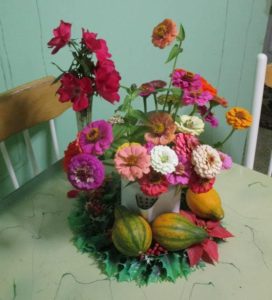
The kitchen table flower display.
ZINNIAS IN THE GARDEN: This week, my zinnias were distributed to the Helmetta Post Office, the lovely Pamela’s, and Jamesburg Dental Care (where I had my first dental appointment 55 years ago under Dr. Lew Goldstein). Butterflies continue to visit my zinnia patch.
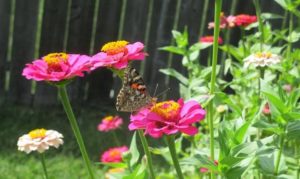
A painted lady, “Vanessa cardui,” in the zinnia patch.
HURRICANE JOSE, THE GOOD: Jose’s effects brought out sightseers to look at the roughness of the ocean. And I saw parasailing surfers taking advantage of the winds at the Atlantic Ocean at Sea Bright, Monmouth County.

A parasailing surfer in the Atlantic Ocean at Sea Bright, Monmouth County.
WEEDS IN THE YARD: When I see some kind of vegetation popping up in the yard, I let it grow to observe it. So, year after year, pokeweed, “Phytolacca americana,” pops up, one plant along my driveway, another in my garden. Here is an interesting article on this complicated plant, http://nadiasyard.com/our-native-plants/american-pokeweed/.
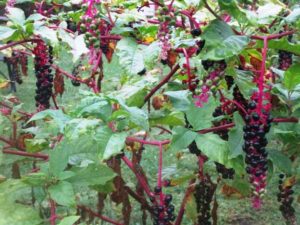
Pokeweed in the garden.
MONMOUTH CONSERVATION FOUNDATION: A shout-out to the Monmouth Conservation Foundation, a not-for-profit land preservation group in Monmouth County, as it celebrates its 40th anniversary. Over the 40 years, it has helped save more than 22,000 acres of open space. (The Foundation recently contracted me to write two articles – one on the group’s origin and another on Monmouth County wildlife — for one of its upcoming publications.)
OCEAN TEMPERATURES: Atlantic Ocean temperatures on the New Jersey coast were about 69 degrees to 74 degrees on the weekend of September 23-24.
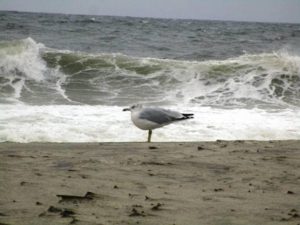
A gull at the Atlantic Ocean beach at Sea Bright, Monmouth County.
SUNRISE/SUNSET: For September 24, Sunday, to September 30, Saturday, the sun will rise about 6:50 a.m. and set about 6:45 p.m. For October 1, Sunday, to October 7, Saturday, the sun will rise about 6:55 to 7 a.m. and set about 6:30 to 6:40 p.m.
THE NIGHT SKY: The next full moon is the Full Harvest Moon October 5, Thursday.
WEATHER: The National Weather Service forecasting station for the area is at http://www.weather.gov/phi/.
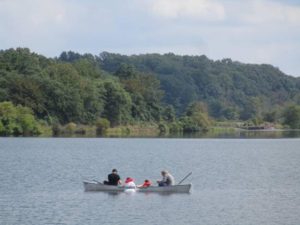
“Jamesburg Lake,” or more properly “Lake Manalapan,” on the boundary of Monroe and Jamesburg, Middlesex County, is about 35 to 40 acres. On the Outer and Inner Coastal Plains, there are few, if any, natural bodies of water. So, Jamesburg Lake on the Inner Coastal Plain is formed by the damming of Manalapan Brook.
Joe Sapia, 60, is a lifelong Monroe resident. He is a Pine Barrens naturalist and an organic vegetable-fruit gardener. He gardens the same backyard plot as did his Italian-American father, Joe Sr., and his Polish-immigrant, maternal grandmother, Annie Poznanski Onda. Both are inspirations for his food gardening. Joe is active with the Rutgers University Master Gardeners/Middlesex County program. He draws inspiration on the Pine Barrens around Helmetta from his mother, Sophie Onda Sapia, who lived her whole life in these Pines, and his Grandma Annie. Joe’s work also is at @JosephSapia on Twitter.com, along with Facebook.com on the Jersey Midlands page.
Article and photos by Joe Sapia
Note: The yard references are to my house in the section of Monroe between Helmetta and Jamesburg in South Middlesex County. My yard is in a Pine Barrens outlier on the Inner Coastal Plain, the soil is loamy, and my neighborhood is on the boundary of Gardening Zones 6b (cooler) and 7a (warmer). Notes and photographs are for the period covered, unless otherwise noted.
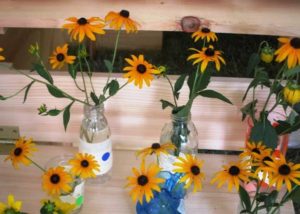
Flowers on display at the Monmouth County Fair, which runs through Sunday, July 30, in Freehold Township.
THE DRIVE-BY NATURALIST, FLICKER: I aim to check the family gravesites once a month, with one of my visits to Saint James Cemetery in Monroe. There, I observed a bird I normally only get a glimpse of, flying off when spooked, the northern flicker, “Colaptes auratus” – in Greek, the genus name referring to “peck” because the flicker is a woodpecker and the species name referring to its “golden” underwing, according to the Texas Parks and Wildlife website. The flicker, whose body is generally tan with black speckles, is easily identifiable when it flies off because of its white rump. The flicker is a year-round resident.

A flicker at St. James Cemetery, Monroe.
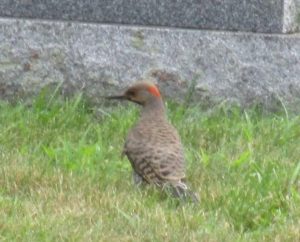
The Saint James Cemetery flicker.
IN THE GARDEN: I picked multi-color carrots and green tomatoes for a salad. A true tomato crop will be iffy because some animal is snipping the tops of the plants. Sweet corn should be ready for picking soon (if the deer or raccoons do not get to it), although I noticed some yellowing of the leaves, probably attributable to the recent wet conditions. The rains apparently caused the splitting of a cantaloupe – basically, the rain forcing the fruit to develop more quickly than it is capable. So, I am backing off on watering at least the cantaloupe. The missing cucumbers are no longer missing; they are fruiting. I thought the tomatillos – which I did not plant and do not know where they came from – were ready for harvest, but they are still developing.

Pick green tomatoes and multi-color carrots from the garden, add balsamic vinaigrette dressing, and, voila, Joey’s Garden Garden Salad.
MY GARDEN WATERING OBSESSION: My two water barrels are pretty full, meaning I have about 50 gallons of non-house water on hand. The water is from various sources, including rainwater and recycled water from the cellar dehumidifier. But, after talking to other gardeners about watering, most recently Diane Larson, the horticulturist at the Rutgers University Cooperative Extension/Monmouth County, I am backing off on my daily watering. Instead of a daily watering, I am going to an every-other-day watering or even a less-frequent watering.
THE DRIVE-BY NATURALIST, KINGBIRD: As I walked around Saint James Cemetery, I noticed a bird I had not observed in years perched on a utility line, the eastern kingbird, “Tyrannus tyrannus.” It, too, is easily identifiable: dark head, white chin and underbelly, a white border to its dark tail. As the Cornell University All About Birds website says, “With dark gray upperparts and a neat white tip to the tail, the Eastern Kingbird looks like it’s wearing a business suit. …The scientific name ‘Tyrannus’ means ‘tyrant,’ ‘despot,’ or ‘king,’ referring to the aggression kingbirds exhibit with each other and with other species.” Here, it is a summer breeder eating insects, migrating to South America to spend winters and mainly eat fruit. An interesting fact, according to All About Birds, “Eastern Kingbirds apparently rely almost completely on insects and fruit for moisture; They are rarely seen drinking water.”

Pick green tomatoes and multi-color carrots from the garden, add balsamic vinaigrette dressing, and, voila, Joey’s Garden Garden Salad.
MY GARDEN WATERING OBSESSION: My two water barrels are pretty full, meaning I have about 50 gallons of non-house water on hand. The water is from various sources, including rainwater and recycled water from the cellar dehumidifier. But, after talking to other gardeners about watering, most recently Diane Larson, the horticulturist at the Rutgers University Cooperative Extension/Monmouth County, I am backing off on my daily watering. Instead of a daily watering, I am going to an every-other-day watering or even a less-frequent watering.
THE DRIVE-BY NATURALIST, KINGBIRD: As I walked around Saint James Cemetery, I noticed a bird I had not observed in years perched on a utility line, the eastern kingbird, “Tyrannus tyrannus.” It, too, is easily identifiable: dark head, white chin and underbelly, a white border to its dark tail. As the Cornell University All About Birds website says, “With dark gray upperparts and a neat white tip to the tail, the Eastern Kingbird looks like it’s wearing a business suit. …The scientific name ‘Tyrannus’ means ‘tyrant,’ ‘despot,’ or ‘king,’ referring to the aggression kingbirds exhibit with each other and with other species.” Here, it is a summer breeder eating insects, migrating to South America to spend winters and mainly eat fruit. An interesting fact, according to All About Birds, “Eastern Kingbirds apparently rely almost completely on insects and fruit for moisture; They are rarely seen drinking water.”
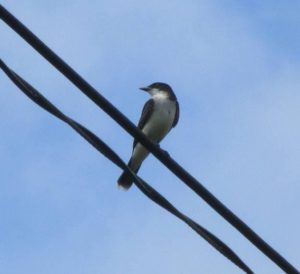
The Saint James Cemetery kingbird.
FALL CROPS: I should get carrots, lettuce, beets, and peas in the ground around August 1, although my tight schedule will probably delay that planting. Around August 15, I am looking to plant spinach.
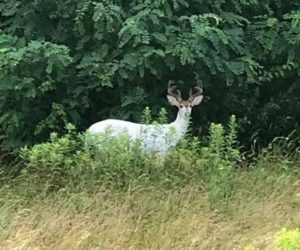
This white-tailed deer, “Odocoileus virginianus,” in a genetic piebald state lives in the Route 130 area of Cranbury, Middlesex County. Thanks to George Nikitiades, whose family owns Teddy’s luncheonette in Cranbury, for passing along this photograph.
THE DRIVE-BY NATURALIST, DEER: As I was driving to the Monmouth County Fair, I passed a soybean field in Monroe and noticed a doe with her two fawns. The good thing for me, I captured some nice photographs. As for the farmer, his or her crops are likely being shared with these deer.
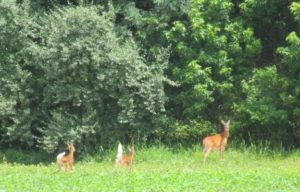
The Monroe doe and her fawns.
MONMOUTH COUNTY FAIR: The Monmouth County Fair, operated by the county Park System, completes its five-day run Sunday, July 30. This fair has a little bit of everything – and I like it because it retains the Old Jersey farm, garden, animal, and home exhibits. I spent some time there with retired county Agricultural Agent Rich Obal, county plant horticulturist Diane Larson, and Master Gardeners judging vegetables, flowers, and herbs. It was good to see Rich, whom I dealt with as an Asbury Park Press reporter over 30 years. And a shout out to Diane, who runs the Master Gardeners program, for continuing to answer my questions over the years.
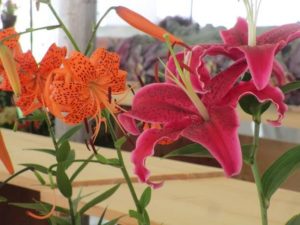
Flowers at the Monmouth County Fair.
QUEEN ANNE’S LACE: Outdoorswoman Priscilla “Peppy” Bath of Hamilton, Mercer County, noted, “The Queen Anne’s lace is outstanding this year. When I was a little kid I would put some stems of Queen Anne’s lace in ink and watch the flowers turn blue.” I, too, have noticed a lot of Queen Anne’s lace, ““Daucus carota,” this year. And, now that Peppy has given me the idea, I will have to go out and buy some food coloring.
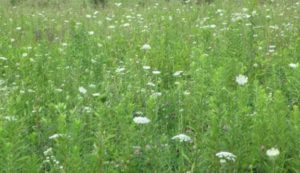
Queen Anne’s lace blooming in a fallow field at Heavenly Farms, East Brunswick, Middlesex County.
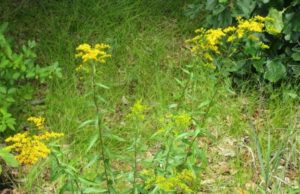
Goldenrod, genus “Solidago,” is blooming along roadsides. Here, it blooms along ConRail railroad tracks in Monroe.
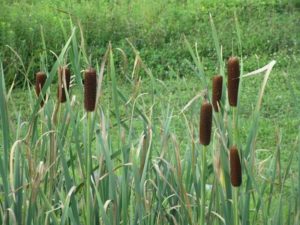
Punks, or cat-tails, genus “Typha,” are in flower in wetlands.. These were photographed at Heavenly Farms in East Brunswick, Middlesex County.
GARBAGE IN THE WOODS: Because of development, destruction caused by off-road vehicle riding, and littering or garbage dumping, we are losing the battle to protect open space. Earlier this month, I came across living room furniture dumped along an East Brunswick, Middlesex County, public road passing through the Jamesburg Park Conservation Area. Middlesex County Parks and Recreation responded and removed the trash. The Jamesburg Park Conservation Area is approximately 1,400 acres of Pine Barrens ecosystem in East Brunswick, Helmetta, Spotswood, and Monroe. It is home to one of the few Atlantic white cedar swamps in the area, along with pine-oak forest, orchids, carnivorous plants, various wildlife (including the carpenter frog, which could be at its northernmost location, here.) See http://www.middlesexcountynj.gov/…/PR/Jamesburg-Park-CA.aspx. It is truly a jewel that needs to be respected, so that future generations can enjoy it, too. I take this personally — My family through my maternal side has walked afield in what is now the conservation area for more than 100 years and I have been a volunteer at Jamesburg Park for years. If anyone recognizes this furniture and knows the owner, please report it to Parks and Recreation, telephone 732-745-3900.
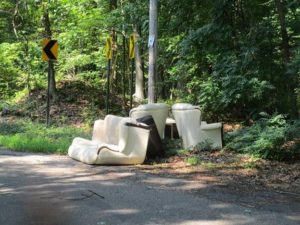
The furniture dumped at the Jamesburg Park Conservation Area.
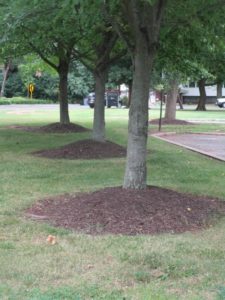
I thought this tree-mulching scene was ironic because it is on Rutgers University’s Douglass-Cook campus. Cook is where Rutgers agriculture studies are based. And these volcano-like mounds are the wrong way to mulch! Creating the volcano-look, or the pileup of mulch against a tree could cause too much wetness around the bark or make the tree susceptible to insect infestation or disease. Instead, use the “doughnut” method of placing the “doughnut hole” outside of the tree and its exposed roots, so the mulch is not touching bark. Outside of the hole, the mulch should be about only 2 or 3 inches in depth, so as not to overwet the tree. The outer rim of the “doughnut” should go to the end of the root ball or the tree canopy/drip line. If a tree is established, there is no need for mulching.

The Northeast Corridor railroad tracks bridge crossing the Raritan River between New Brunswick, left, and Highland Park, right, in Middlesex County. This photograph shows the day’s changing weather, some rain, some sunshine.
PLEIN AIR ART IN THE GARDEN: One night, I plopped myself in a chair at the edge of my garden and used color pencils to do an artwork of the zinnias, which continue to bloom beautifully.

Zinnias in the garden.
OCEAN TEMPERATURES: Atlantic Ocean temperatures on the New Jersey coast were reported at around 75 degrees on Saturday, July 29.
UPCOMING COUNTY FAIRS: Middlesex County Fair, August 7, Monday, to August 13, Sunday, in East Brunswick, http://middlesexcountyfair.com/. Somerset County 4-H Fair, August 9, Wednesday, to August 11, Friday, in Bridgewater, http://www.somersetcounty4h.org/fair/. Hunterdon County 4-H and Agricultural Fair, August 23, Wednesday, to August 27, Sunday.
SUNRISE/SUNSET: For July 30, Sunday, to August 5, Saturday, the sun will rise at about 5:55 to 6 a.m. and set about 8:10 p.m.
WEATHER: The National Weather Service forecasting station for the area is at http://www.weather.gov/phi/.
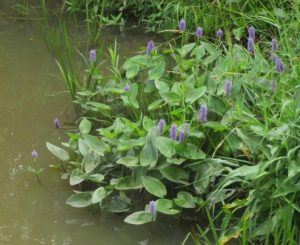
Pickerel weed, “Pontederia cordata,” in bloom on the Millstone River on the boundary of Middlesex County (Monroe and Cranbury) and Mercer County (East Windsor).
Joe Sapia, 60, is a lifelong Monroe resident. He is a Pine Barrens naturalist and an organic vegetable-fruit gardener.
He gardens the same backyard plot as did his Italian-American father, Joe Sr., and his Polish-immigrant, maternal grandmother, Annie Poznanski Onda. Both are inspirations for his food gardening. Joe is active with the Rutgers University Master Gardeners/Middlesex County program. He draws inspiration on the Pine Barrens around Helmetta from his mother, Sophie Onda Sapia, who lived her whole life in these Pines, and his Grandma Annie. Joe’s work also is at @JosephSapia on Twitter.com, along with Facebook.com on the Jersey Midlands page.
What is the most common type of litter in Boyd Park? Is there more paper or plastic in the grass? How many cigarette butts can you find? How many bottle caps? What is the most unusual item hiding in the bushes?
Join the LRWP and coLAB Arts on Sunday September 10, 10-noon for a River Health Workshop and “Scavenger Hunt” Clean-up of New Brunswick’s Boyd Park!
This event is coordinated in conjunction with the DIY MARKET at Rock New Brunswick. DIY Market is an open air marketplace that celebrates the creativity and spirit of the New Brunswick music scene. It is being held in Boyd Park, alongside a day-long homegrown New Brunswick music festival.
Article and photos by Joe Sapia
Note: The yard references are to my house in the section of Monroe between Helmetta and Jamesburg in South Middlesex County. My yard is in a Pine Barrens outlier on the Inner Coastal Plain, the soil is loamy, and my neighborhood is on the boundary of Gardening Zones 6b (cooler) and 7a (warmer). Afield references are to the Pine Barrens around Helmetta, unless otherwise noted. Notes and photographs are for the period covered, unless otherwise noted.
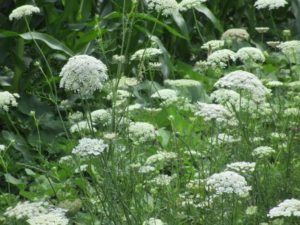
Queen Anne’s lace along a roadside in Monroe, Middlesex County.
THE DRIVE-BY NATURALIST: During the week, I noticed the white-flowered Queen Anne’s lace, “Daucus carota,” blooming along various roadsides. Also, blue-flowered chicory, “Cichorium intybus,” remains in bloom. This got me thinking, how we can observe nature as we drive by. As I try to point out, keep your eyes open – for plantlife and wildlife, along with looking up at the daytime and night skies. Nature is around us, so do not miss out on it. And keep the camera ready!
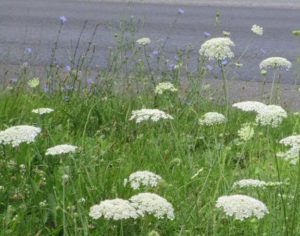
Here, Queen Anne’s lace, the white flower, and chicory, the blue flower, in bloom along a roadside.
ON MY DRIVE-BYS: Despite the warm temperatures during the week, I have been watching for the changing colors of foliage. Yes, it is only July, but the “fall” foliage changing of colors should be starting right about now in the wetlands in the Pine Barrens around Helmetta. I have not seen it yet, but I generally look for changing colors in swamps beginning somewhere in the July 15-to-July 31 period.
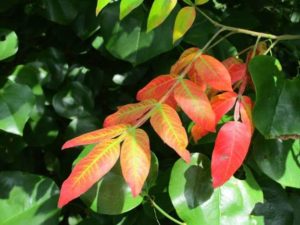
Here, leaves changing colors in 2015, late July, at Cranberry Bog in the Pine Barrens around Helmetta.
SPOTTED ON A DRIVE-BY: As I was putting together this week’s “Garden and Afield,” I shot some last-minute photographs and was driving home when I noticed some deer, “Odocoileus virginianus,” just off the road near Manalapan Brook on the Monroe-Spotswood boundary, Middlesex County. Usually when you see a fawn, Mama is nearby. On this day, though, I caught what I consider an uncommon sight, fawns and a buck (whose antlers were in velvet). Mama Deer was probably keeping an eye on the fawns from nearby in the woods.
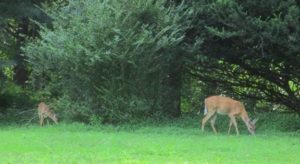
A fawn and a buck in Monroe, Middlesex County.
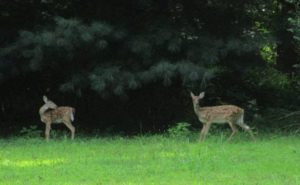
Two fawns in Monroe, Middlesex County.
LOW-MOISTURE-IN-THE-AIR BLUE SKY: Ever notice days when the sky just has that clear look to it? Based on my Roman Catholic upbringing and 16 years in Catholic schools, I call it a “Blessed Mother Blue Sky,” because the sky has the look of the blue clothing associated with the Virgin Mary. Joey Slezak, my go-to science guy in the Pine Barrens around Helmetta, calls it a “Bluebird Sky.” “The first I heard ‘Bluebird Skies’ is (when I was) skiing,” Joey said. “People talking about it. You have white (snowy) ground contrasting the blue sky.” Joey, who has a bachelor’s degree in meteorology from Rutgers University and has completed his master’s degree course work in meteorology at the university, explained the clearness translates as “low moisture” in the air.
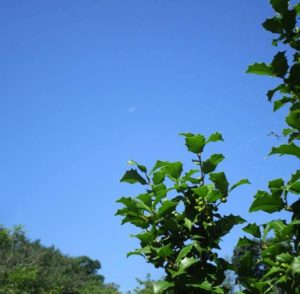
The clear blue sky is a result of low moisture in the air as the moon wanes after the July 8-9 overnight Full Thunder Moon. The next full moon is the August 7-8 overnight Full Red Moon
GARDEN ENEMIES: I have not seen the ground hog and its offspring lately, although the wood steps at one of my house doors is collapsing into their burrow. The rabbits are always around. Then, the other day, I found deer droppings and hoof prints in my garden. Finally, I found the tops of my tomato plants snipped off. Well, there goes this year’s tomato crop….
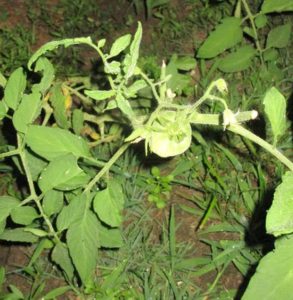
A snipped-off tomato plant in the garden.
WATERING THE GARDEN OBSESSION, NO. 1: On Sunday, July 16, for the first time since planting the food garden around May 20, I was able to water it completely by hand, using water I had accumulated in garbage can reservoirs. I used roughly 30 gallons for the 950-square-foot, or 315-row-feet garden. Now, to replenish the 20-gallon and 30-gallen barrels with rainwater, cellar de-humidifier water, water caputured while sprinkling the garden using the house system, and water from Manalapan Brook. (I keep the barrels covered so as not to promote mosquito development.)
WATERING THE GARDEN OBSESSION, NO. 2: With the water accumulated in my barrels, I thought I could cheat a little, by hooking up a simmer pump and hose to a sprinkler, rather than walking the garden with sprinkling cans. Well, I clogged the sprinkler, which required me unclogging it – but not until I gave up on using the pump for sprinkling. I guess the pump picked up gunk from the water barrel. And I am not even sure the pump was powerful enough to propel the sprinkler properly.
WATERING THE GARDEN, OBSESSION NO. 3 — MANALAPAN BROOK: I grabbed two buckets and took the walk of a few hundred feet to Manalapan Brook, the section between “Jamesburg Lake” (Lake Manalapan) and “Spotswood Lake” (DeVoe Lake). There, I was greeted by my friends, ebony jewelwing damselflies, “Calopteryx maculate.” I waded into the Brook, filled the two buckets, took some photographs, and headed home.
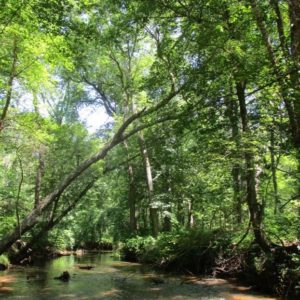
Manalapan Brook in the section of Monroe between Helmetta and Jamesburg, looking downstream toward Helmetta.
ELSEWHERE IN THE GARDEN: I am awaiting cantaloupe/mushmelon and sweet corn, both seemingly behind on the calendar from last year. The tomatillos, which I did not plant, are ready for harvesting; I will pass them along to a co-worker. Otherwise, I had some pea seeds laying around I decided to plant about a week or so ago; They are sprouting.
THE SIZE OF MY GARDEN: Friend, fellow hiker, and fellow gardener Priscilla “Peppy” Bath had an interesting observation about my garden: “Your vegetable garden is so good as you tell about it. I expected it to be much bigger. …Perhaps it would be interesting to others that you do not have one to two acres, but just a normal back yard.” Yes, my yard is only about a quarter-acre. “It would possibly encourage others to make a vegetable garden in their backyards,” Peppy said. I think people do not realize how productive a small garden could be. So, I reached out to friend Diane Larson, who is the home horticulturist and Master Gardener coordinator for the Rutgers University Extension Service office in Freehold, Monmouth County. The Monmouth County Master Gardeners garden is about 40 feet by 50 feet, or about 2,000 square feet. From 2006 to 2016, or over 11 growing seasons, the garden has produced 26,000 pounds of vegetables – an average of about 2,364 pounds per year, all donated to food pantries serving the needy. “The best part, besides all the produce going to food pantries, is that the MGs learn so much out there,” Diane said. “Some have never grown vegetables and they love it.”
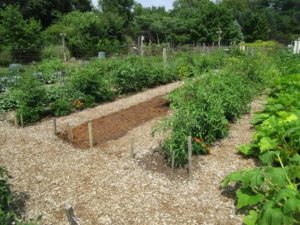
The Monmouth County Master Gardeners garden in Freehold Township. This 40-foot by 50-foot garden has averaged a yield of 2,364 pounds per year from 2006 to 2016, with all the food donated to the needy.

Another view of the Monmouth County Master Gardeners garden.
ZINNIA OBSESSION: My new obsessive-compulsive fascination – the zinnias I planted to attract pollinators to the food garden. For next year, I plan to dig up the front lawn and plant zinnias there, too.

Zinnias in the garden.
FIRE IN THE MAIN PINE BARRENS: A wildfire has burned about 3,500 acres in Wharton State Forest. The fire remained burning as of Saturday, July 22. The good news is the fire — whose cause is, so far, undetermined — is not near buildings, which means the fire, too, will help keep the Pine Barrens a pine barrens. The Pine Barrens is an early succession ecosystem, so the fire – by knocking down the oaks that would shade out the pines – keeps succession in check. The pines may look like burned spars, but they are alive and can regenerate from their trunks, along with root growth and new growth of wildfire-spread seeds; The oaks, on the other hand, cannot regenerate from the trunks, but have to start all over, so to speak, by root growth. On Saturday, the fire was considered “contained,” meaning firefighters had a safe perimeter around it.
ELSEWHERE IN THE YARD: I am slowly reclaiming my yard after 4-1/2 weeks of a major remodeling project on my house – new roof, soffits, gutters and drainpipes, and siding. (For the first time since the house was built in 1952, it is no longer mint green. The retro green has been replaced by barn red.) So, I have been cutting the lawn and trimming shrubs, along with figuring how to approach my neglected garden. And I finally put up the screen tent that has been sitting in a box in my garage for a few weeks. Now, without getting bit by mosquitoes, I can spend warm nights in the screen tent reading, writing, listening to the radio, or just enjoying being outside. Next year, I plan to put the screen tent in a better location, farther from the house, closer to the garden. So, I put up the screen tent and almost immediately it began raining, then monsooning. …Oh, yes, the contractors still have a few odds and ends to finish, but I do have the yard back under my control.
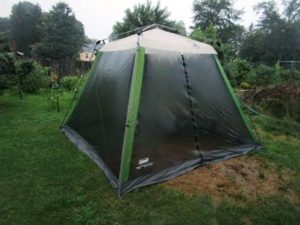
The brand-new, and rain-drenched, screen tent in my backyard.
SOURCES, BOOK NO. 1: One of my book sources is “Dictionary of Plant Names” by Allen J. Coombes, 1985 to 1989, Timber Press. I have had this book for an estimated 25 or more years and have repeatedly turned to it. It lists plants by common and scientific names, cross-referencing the two – for example, mountain laurel, “Kalmia latifolia.” It goes on, saying the genus name is from naturalist Pehr Kalm (who did work in the 1700s in the South Jersey area) and the species name translates from Latin as “broad-leaved.” Mountain laurel, according to the book, is also known as “calico bush.” I use this book both on its own and in conjunction with plant-illustration books.

“Dictionary of Plant Names” by Allen J. Coombes
TURKEY FOLLOWUP: Bob Eriksen, a retired turkey biologist of the state Department of Environmental Protection, made some observations after seeing the photograph of the wild turkeys, “Meleagris gallopavo,” in the Pine Barrens around Helmetta published in the July 9 “Garden and Afield.” Bob said, “Good to see a hen turkey with at least three poults. They are all old enough that they likely will survive to adulthood.”
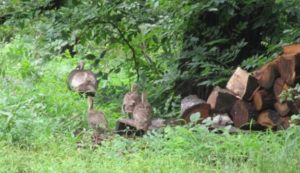
A turkey hen and her three poults in the Pine Barrens around Helmetta, specifically in the Jamesburg Park section of East Brunswick, Middlesex County.
ATLANTIC OCEAN TEMPERATURES: The ocean temperatures have run from about 70 degrees to the lower 80s. On July 18, Tuesday, Glenn “Hurricane” Schwartz, a Philadelphia television Channel 10 meteorologist, said online, “The Atlantic City ocean temperature is now up to 80 degrees. That’s practically unheard of for July. (It) peaks in August. 10 degrees above average.”
UPCOMING COUNTY FAIRS: Monmouth County Fair is July 26, Wednesday, to July 30, Sunday, in Freehold Township, https://www.monmouthcountyparks.com/page.aspx?ID=2492. Mercer County 4-H Fair, July 29, Saturday, and July 30, Sunday, in Hopewell Township, http://mercer.njaes.rutgers.edu/4h/fair/. Middlesex County Fair, August 7, Monday, to August 13, Sunday, in East Brunswick, http://middlesexcountyfair.com/. Somerset County 4-H Fair, August 9, Wednesday, to August 11, Friday, in Bridgewater, http://www.somersetcounty4h.org/fair/. Hunterdon County 4-H and Agricultural Fair, August 23, Wednesday, to August 27, Sunday.
SUNRISE/SUNSET: For July 23, Sunday, to July 29, Saturday, the sun will rise at about 5:50 a.m. and set about 8:18 p.m.
WEATHER: The National Weather Service forecasting station for the area is at http://www.weather.gov/phi/.
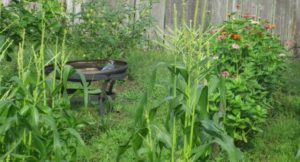
A blue jay rests in the garden, surrounded by sweet corn, tomatillos, and zinnia.
Joe Sapia, 60, is a lifelong Monroe resident. He is a Pine Barrens naturalist and an organic vegetable-fruit gardener.
He gardens the same backyard plot as did his Italian-American father, Joe Sr., and his Polish-immigrant, maternal grandmother, Annie Poznanski Onda. Both are inspirations for his food gardening. Joe is active with the Rutgers University Master Gardeners/Middlesex County program. He draws inspiration on the Pine Barrens around Helmetta from his mother, Sophie Onda Sapia, who lived her whole life in these Pines, and his Grandma Annie. Joe’s work also is at @JosephSapia on Twitter.com, along with Facebook.com on the Jersey Midlands page.
Monday September 18 is World Water Monitoring Day!
Join the LRWP and coLAB arts to celebrate with an after-work picnic (5:30-7:30pm) along New Brunswick’s Boyd Park waterfront! Bring your dinner (or something to share). We’ll supply beverages, paper products and dessert. RSVPs requested: hfenyk@lowerraritanwatershed.org
The event will include water quality monitoring demos (ph, salinity, phosphorus, nitrate-nitrogen, turbidity, dissolved oxygen), project updates on the Rail-Arts-River and “frames” sculptural installation, picnicking and a Raritan River “story slam” with coLAB Arts.
Want to participate in the Story Slam? We are looking for 4-5 people to tell their stories about the Raritan River at our September 18 event. Do you have a special, original Raritan River story to share? Let us know by August 31! We’ll then make arrangements for you to work with coLAB’s Dusty Ballard and John Keller who will help you prepare to tell your story on stage. This must be a personal, true story, that happened to you where you are the central character and it should somehow relate to the Raritan River or Lower Raritan Watershed. Though we love fiction, we’re interested in the truth. Your truth. Spill all of the details!
Stories must be within a 4-to-8-minute time frame. Tell ONE story with a beginning middle and end containing a series of events that grow to a climax. Though we love stand up comedy, this is not a stand up set. We’re only interested in the thoughts, feelings, and emotions you experienced through this ONE story from your life that you’ve prepared.
Contact hfenyk@lowerraritanwatershed.org if interested in the Story Slam, and to RSVP.
Article and photos by Joe Sapia
Note: The yard references are to my house in the section of Monroe between Helmetta and Jamesburg in South Middlesex County. My yard is in a Pine Barrens outlier on the Inner Coastal Plain, the soil is loamy, and my neighborhood is on the boundary of Gardening Zones 6b (cooler) and 7a (warmer). Afield references are to the Pine Barrens around Helmetta, unless otherwise noted. Notes and photographs are for the period covered, unless otherwise noted.
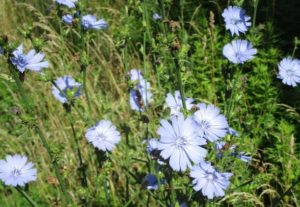
Blooming along a roadside in East Windsor, Mercer County, the beautiful, but non-native, chicory, “Cichorium intybus.”
IN THE FOOD GARDEN: I picked a cherry tomato and some carrots. Otherwise, the garden is between harvesting the early season crop of lettuce and awaiting the warmer weather crop of sweet corn, cantaloupe/mushmelon, and more tomatoes. So, come on pollination – the sweet corn has begun forming tassels (the male flower) and some silk (the female flower), while the mushmelon continues to flower in yellow.
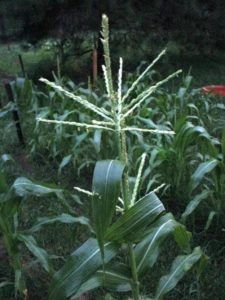
Tassels, or the male flower, on the sweet corn in the garden.
ZINNIA IN THE FOOD GARDEN: Hopefully attracting pollinators to the food garden this year are the score of blooming zinnia of orange, yellow, purple, pink, white, and rose. I have been watching more and more flowers develop this week and, in turn, various pollinators – butterflies, bees, and flies – visiting the zinnia. This is my first year using zinnia, getting the idea from watching pollinators visiting the zinnia at Bobby Laurino’s R.J. Laurino Farms in Colts Neck (www.rjlaurinofarms.com) and Andy Capelli’s Capelli Farms in Middletown (www.capellifarms.com). For next year, I plan to go zinnia-crazy, interspersing rows throughout the food garden and converting more lawn to zinnia growing.
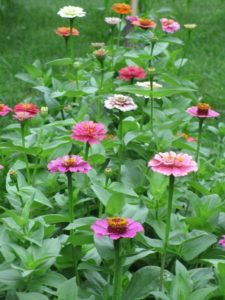
Zinnia in bloom in the garden.
FRUITING IN THE WILDS: Heads up in the wilds, blackberries, genus “Rubus,” should be fruiting here and there. Yes, they are edible – and taste great! From the New Jersey Department of Agriculture, http://www.nj.gov/agriculture/farmtoschool/documents/seasonality-chart/F2S%20Blackberries.pdf.
NEW BRUNSWICK IN FLOWER: I work part-time at Rutgers University’s Jules and Jane Plangere Writing Center at the College Avenue Campus in New Brunswick. But my parking area is cross-town, about 2 miles away at the Douglass College campus. This time of year, especially, I try to walk both ways. The walk gives me a great opportunity to photograph the city of my birth – St. Peter Hospital, Class of 1956. This week, I photographed flowers – white, light pink, dark pink, yellow, red. (Side note: For about half of my 31-year newspaper reporting career at the Asbury Park Press, Mr. Plangere was an owner. Mr. Plangere died in September at 95 years old – but he is still taking care of me!)

Flowering New Brunswick.
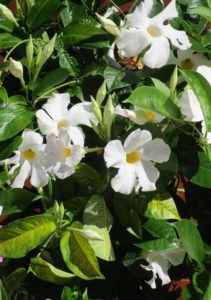
More of flowering New Brunswick.
STARLINGS: Blame these European invaders on lovers of playwright William Shakespeare! According to Cornell University’s All About Birds website, “All the European Starlings (“Sturnus vulgaris”) in North America descended from 100 birds set loose in New York’s Central Park in the early 1890s. The birds were intentionally released by a group who wanted America to have all the birds that Shakespeare ever mentioned. It took several tries, but eventually the population took off. Today, more than 200 million European Starlings range from Alaska to Mexico, and many people consider them pests.”
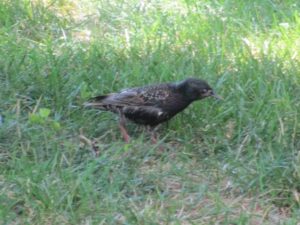
A starling on a New Brunswick lawn.
GARDEN TOOLS: As an only child, I inherited the house I grew up in, moving back to it in 2002. My parents, Joe Sapia Sr. and Sophie Onda Sapia, are the original owners of the house, dating to 1953 and my maternal grandmother, Annie Poznanski Onda, moved in with us in probably 1966. So, basically, three generations have lived here, meaning three generations of “stuff” reside here. When I moved back, I rented a 30-cubic-yard trash bin and cleaned house, except for things that were sentimental and things I figured I could use. So, today, if I need something, before I go out and buy it, I check if I have it around the house or check to see if I can rig something together from what I have around the house. This includes gardening tools. I have a shovel I use frequently and a garden claw for weeding, both with loose handles. A few days ago, I got tired of this loose-handle stuff. So, I used a technique Uncle John Onda taught me when I was a kid: place the item in water, the wood will swell, end of the loose object. I taped the claw and the shovel to the way I wanted the handles positioned, then I put them in my 20-gallon garbage can of gardening water I keep handy. About 36 hours later, I pulled them out – gardening tools that no longer have loose handles. This week, I took another shovel and am doing the same thing.
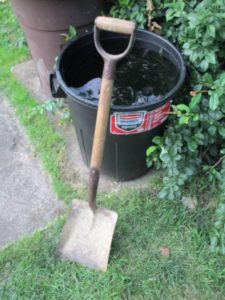
This shovel is about to be soaked in the barrel of garden water.
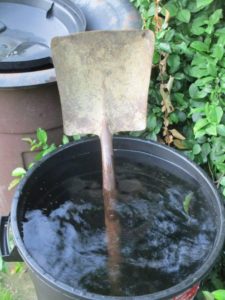
The shovel handle soaking, and swelling, in the barrel of gardening water.
OCEAN TEMPS: Atlantic Ocean water temperatures at the Jersey Shore are running at about 73 degrees to 76 degrees. The average at Sandy Hook for July 16 to 31 should be 71 degrees, according to the National Oceanic and Atmospheric Administration (NOAA).
RIP CURRENTS: This season, you may have seen various warnings of rip currents during television or radio weather reports. Rip currents – also referred to incorrectly as “rip tides” – are currents of water being returned to the ocean from the beach. A rip current dissipates within hundreds of feet, but that is enough time to sweep a swimmer out into the ocean or make it difficult for that swimmer to swim back to the beach against a rip. Basically, there are three things a swimmer can do. One, rips are relatively narrow, so the swimmer can try getting out of the rip by swimming parallel to Shore, rather than back in, until he or she is out of the rip. Two, ride out the rip and, then, swim parallel to Shore and back in. Three, float and signal for help. See NOAA’s advice, http://www.ripcurrents.noaa.gov/surviving.shtml.
WHITE ORCHID IN THE PINES: As its name suggests, the pink lady slipper orchid, “Cypripedium acaule,” generally has a pink flower. But rarely, the flower can be white. During this year’s pink lady slipper blooming season, basically late April-early May into June, outdoorsman Jay Schoss, who is a trustee of the Outdoor Club of South Jersey, found a rare white one in the Whitesbog, Burlington County, area of the Pine Barrens. I have never seen one that I can recall in my 60 years! A great find. (Thanks to outdoorswoman Faye Bray, an Outdoor Club member, for taking the photo and coming through in supplying it. The white variety was “freaking remarkable” and “absolutely beautiful,” Faye said. If you get a chance, take an OCSJ hike led by Jay or Faye. Both are great leaders and great people.)
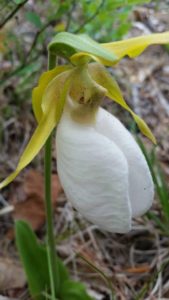
rare white flower of a pink lady-slipper orchid.
LAST WEEK’S DRAGON FLY: Roger Dreyling, a lifelong Jamesburg area outdoorsman and my cousin through marriage, identified the dragonfly I could not identify last week. It is a common whitetail, “Plathemis lydia.”
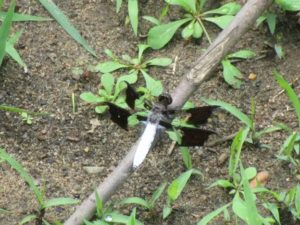
A common whitetail dragonfly in the garden earlier in July.
SUNRISE/SUNSET: For July 16, Sunday, to July 22, Saturday, the sun will rise at about 5:45 and set about 8:25 p.m.
WEATHER: The National Weather Service forecasting station for the area is at http://www.weather.gov/phi/.
NORTHERN LIGHTS: Mass ejections from an explosion at the Sun are to reach Earth Sunday, July 16, possibly enhancing viewing of the Aurora Borealis, or “Northern Lights.” The National Weather Service is saying the Northern Lights may be visible as far south as the Great Lake States and New England. Hmmmm, close enough to us to take a look into the Night Sky on the Sunday-Monday overnight.
I HAVE GOT MY YARD BACK: After almost five weeks of a house-remodeling project (altering the roofline, new roof, new siding, new gutters and drainpipes, and little things here and there), I have reclaimed my yard from the contractors – not totally, because a few odds and ends remain in the coming week or two, but generally. This means, I can get back to some very-needed yardwork – cutting the lawn, trimming the shrubs, and maintaining the garden.
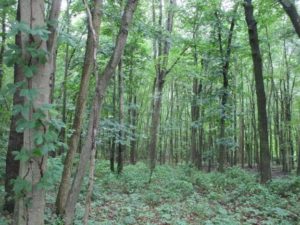
The hardwood forest at Van Dyke Farm, a combination of farm and woods in South Brunswick, Middlesex County.
Joe Sapia, 60, is a lifelong Monroe resident. He is a Pine Barrens naturalist and an organic vegetable-fruit gardener.
He gardens the same backyard plot as did his Italian-American father, Joe Sr., and his Polish-immigrant, maternal grandmother, Annie Poznanski Onda. Both are inspirations for his food gardening. Joe is active with the Rutgers University Master Gardeners/Middlesex County program. He draws inspiration on the Pine Barrens around Helmetta from his mother, Sophie Onda Sapia, who lived her whole life in these Pines, and his Grandma Annie. Joe’s work also is at @JosephSapia on Twitter.com, along with Facebook.com on the Jersey Midlands page.
Article and photos by Joe Sapia
Note: The yard references are to my house in the section of Monroe between Helmetta and Jamesburg in South Middlesex County. My yard is in a Pine Barrens outlier on the Inner Coastal Plain, the soil is loamy, and my neighborhood is on the boundary of Gardening Zones 6b (cooler) and 7a (warmer). Afield references are to the Pine Barrens around Helmetta, unless otherwise noted. Notes and photographs are for the period covered, unless otherwise noted.
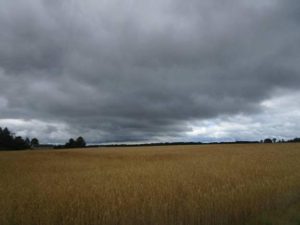
A rainy day begins to clear at a farm on Plainsboro Road in Cranbury, Middlesex County.
IN THE GARDEN: Harvesting-wise, the garden has slowed down, with the lettuce taking on a bitter taste, suggesting it is done for the cool season. I will plant more lettuce later in the summer for the fall season. Otherwise, I wait for tomatoes, corn, and cantaloupe. I do not know what happened to my cucumbers, except that I cannot find any growing. So, again, it is the three Ws: Water, Weed, and Wait. But the big discovery, or re-discovery, was the tomatillo plants growing, and fruiting, in the garden. I never planted them, but, for at least three gardening seasons, there they are. So, add them to my future harvest.
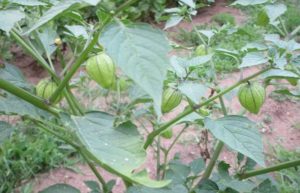
Tomatillos, which I never planted, fruiting in the garden.
AROUND THE YARD: I try to observe, whether it be looking around the yard or the sky (both night and day). As the week wrapped up and I was in the garden, I saw a red-tailed hawk, “Buteo jamaicensis,” soaring over the neighborhood. The Knock Out roses continue blooming nicely, the second bloom of the season. And I am visited by rabbits, probably “Sylvilagus floridanus,” and one of my favorites in wildlife, the catbird, “Dumetella carolinensis.” A catbird, unsure if it is the same one, keeps me company in the yard, whether I am gardening or simply hanging out.

A red-tailed hawk soaring over the neighborhood.
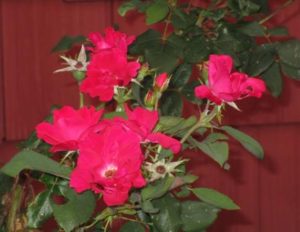
The yard’s Knock Out roses are in their second bloom of the season.
PINE BARRENS AROUND HELMETTA: Over the week, I walked afield only once and briefly. But I am around the wilds and drive paved roads through them daily. And I keep the camera at hand. I photograph a lot in a capture-the-moment way. So, I avoid using a cellphone, because it takes too long to unlock and it is too difficult to maneuver one-handed, instead using a point-and-shoot camera. I keep the camera at the ready — on the dashboard of my Jeep or, when I am doing yard work, in my pocket. Alas, this week, I was driving, I could not stop the Jeep, grab the camera, and focus the camera quickly and properly, missing a good photo of a group of turkeys, “Meleagris gallopavo,” with a deer, “Odocoileus virginianus,” in the background, around a woodpile as I drove past a house in the woods of Jamesburg Park. But I did photograph the turkeys and deer separately.
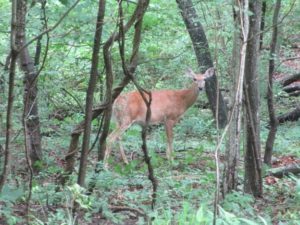
The deer in the Jamesburg Park section of East Brunswick.
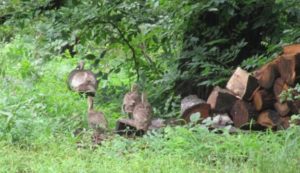
The Jamesburg Park turkeys.
WATERING THE GARDEN: I continue to obsess over watering the garden. This year, I have avoided “brown water,” or already used water such as bath water. Instead, I use freshwater, a combination of house system water, water from Manalapan Brook, captured rain water, and water from the cellar de-humidifier. I water daily, always before 10 a.m. so water is not lost to evaporation in the heat of the day and leaving the day for the plants and soil to dry, keeping fungus away. Now, I am considering watering fewer times a week, but in heavier doses. Friend, gardener, and environmental scientist Virginia Lamb had these thoughts, “I only water maybe twice a week and directly on plants, individual or rows. Probably roughly 2 quarts per plant. … Also you need to add mulching to your list of three Ws. …It will help retain moisture and keep weeds down. Also, add compost to the soil.”
EBONY JEWELWING AT THE BROOK: Manalapan Brook, which my family through my maternal side has lived along more than 100 years, runs about 400 feet from my front door. I regularly take a walk across the street and head to the Brook at the edge of the woods. This week, I encountered one of my favorite wildlife species, the ebony jewelwing damselfly, “Calopteryx maculate” – a beautiful combination of neon green and deep black. Two were flying around. I was hoping at least one would land on my outstretched arm, but not on this day. Eventually, I grabbed a bucket of water for my garden and went back home.
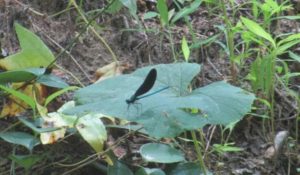
An ebony jewelwing rests along the bank of Manalapan Brook.
DAMSELFLY OR DRAGONFLY: When I was visiting Manalapan Brook, I also saw a dragonfly. What kind? I do not know. But I knew it was a dragonfly because at rest, its wings were like those of an airplane, parallel to the ground. A damselfly rests with its wings perpendicular to the ground.
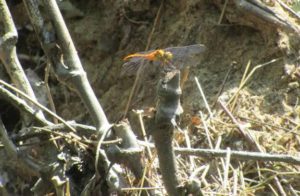
A dragonfly on the bank of Manalapan Brook.
SPOTSWOOD LAKE: Spotswood Lake, also known as DeVoe Lake or Mill Lake, is formed by the damming of Manalapan Brook. I happened to be at Spotswood Lake this week when the moon rose above it early in the night. So, there was a nice combination of the moon and soft sunlight.

The moon over Spotswood Lake.
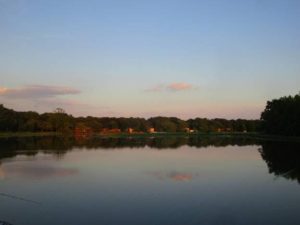
Soft sunlight on Spotswood Lake.
BALD EAGLES: I saw a Facebook report of a bald eagle, “Haliaeetus leucocephalus,” on road kill in Jamesburg. Debbie Sullivan Farrell reported, “Did anyone else see the eagle by the rescue squad at 9:50 this morning? I turned onto Gatzmer from Hillside and was going towards the tracks. An eagle was checking out some road kill and flew off towards the firehouse. It was huge!!! Then I saw the unmistakable white head. It was about 20 feet from me. It was an amazing sight.” The state Department of Environmental Protection 2016 bald eagle nest summary, http://www.conservewildlifenj.org/downloads/cwnj_736.pdf. Bald eagles are “endangered” (in immediate peril) as breeders and “threatened” (could become endangered if conditions persist) as non-breeders. In 1982, there was only one bald eagle nest in New Jersey; Last year, there were about 150.
GROVERS MILL: Does the name of this village in West Windsor, Mercer County, sound familiar. Well, it was the site of the Martian landing in the 1938 radio play adaptation -– by Orson Welles and the Mercury Theatre on the Air — of H.G. Wells’s novel, “The War of the Worlds.” Here is the broadcast that scared the country, https://www.youtube.com/watch?v=Xs0K4ApWl4g. Here is the story of the “panic broadcast,” http://www.smithsonianmag.com/history/infamous-war-worlds-radio-broadcast-was-magnificent-fluke-180955180/.

A view of Grovers Mill Pond from the spillway. The Pond is formed by the damming of Bear Brook.
RECORD GARDEN THOUGHTS: As I work the garden, I have thoughts on how I can improve it in 2018. I likely will not simply remember these ideas, so I am writing them down – things such as rotating crops, keeping only a lawnmower’s width between rows, maybe doing less space between plantings, and so on.
“FALL FOLIAGE” IN THE PINE BARRENS: Summer lovers, you probably do not want to hear about colder weather coming. But those of you venturing into the Pine Barrens, start looking for the changing colors of leaves in the swamps – up here in the Pine Barrens around Helmetta, roughly between July 15 and 31; maybe a week or two later in the main Pine Barrens to the south.
SEX!!!: Last week’s photo of the man turtle loving the woman turtle seems to have recharged the batteries of some readers of Garden and Afield. One woman emailed, “Love that perched turtle.” But this is my favorite e-mail exchange:
“You men love to watch herpetological porn!,” she said. “I’ve seen more pictures of snakes and turtles mating. LOL. Goes across species boundaries.”
“Baptist girls know about herp porn????” I replied.
“I do not seek out frog, turtle or snake porn!” – a likely story.
“It arrives on my desk via studies on sites like the Stafford Business Park, where the native northern pine snakes there were monitored for seven years via radio telemetry,” she continued. “The largest amount of notes was always on how much each individual male scored each season with which female. LOL. Pages and pages and pages of data and photos.”
Uh, she is an environmental scientist who studies herpetological pornography for a living….
SUNRISE/SUNSET: For July 9, Sunday, to July 15, Saturday, the sun will rise at about 5:35 a.m. to 5:40 a.m. and set about 8:25 to 8:30 p.m.
WEATHER: The National Weather Service forecasting station for the area is at http://www.weather.gov/phi/.
CORRECTION/CLARIFICATION: In the 2017, June 4 to 17, issue of Garden and Afield, I referred to a rabbit in the yard. I, likely, had the wrong scientific name. The correct scientific name probably is “Sylvilagus floridanus,” the eastern cottontail.
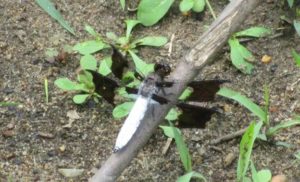
Some kind of dragonfly in the garden.
Joe Sapia, 60, is a lifelong Monroe resident. He is a Pine Barrens naturalist and an organic vegetable-fruit gardener.
He gardens the same backyard plot as did his Italian-American father, Joe Sr., and his Polish-immigrant, maternal grandmother, Annie Poznanski Onda. Both are inspirations for his food gardening. Joe is active with the Rutgers University Master Gardeners/Middlesex County program. He draws inspiration on the Pine Barrens around Helmetta from his mother, Sophie Onda Sapia, who lived her whole life in these Pines, and his Grandma Annie. Joe’s work also is at @JosephSapia on Twitter.com, along with Facebook.com on the Jersey Midlands page.





























































































